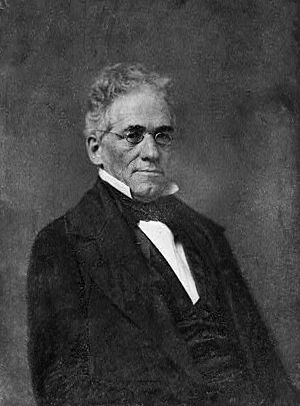George Bush (biblical scholar) facts for kids
Quick facts for kids
George Bush
|
|
|---|---|
 |
|
| Born | June 12, 1796 Norwich, Vermont, U.S.
|
| Died | September 19, 1859 (aged 63) Rochester, New York, U.S.
|
| Alma mater | Dartmouth College Princeton University |
| Occupation | Biblical scholar, pastor, abolitionist |
| Signature | |
George Bush (June 12, 1796 – September 19, 1859) was an American biblical scholar, pastor, abolitionist, and academic. A member of the Bush family, he is a distant relative of both President George H. W. Bush and President George W. Bush.
Biography
Born in Norwich, Vermont, Bush graduated from Dartmouth College in 1818, and then studied theology at Princeton Theological Seminary, where he was a tutor 1823–1824. He was ordained in the Presbyterian ministry, spent four years as a Christian missionary in Indiana, and in 1831 became professor of Hebrew and oriental literature at New York University.
His first book, The Life of Mohammed, was the first American biography of the religious leader. It refers to Muhammad as "remarkable" and "irresistibly attractive", but is a largely negative assessment of him, depicting him as a fraud. It also takes a dim view of the state of Christianity of Muhammad's age. The book fell out of print, but became briefly controversial in Egypt in 2004.
In 1844 Bush published a book entitled The Valley of Vision; or, The Dry Bones of Israel Revived. In it he denounced "the thralldom and oppression which has so long ground them (the Jews) to the dust," and called for "elevating" the Jews "to a rank of honorable repute among the nations of the earth" by restoring the Jews to the land of Israel where the bulk would be converted to Christianity. This, according to Bush, would benefit not only the Jews, but all of mankind, forming a "link of communication" between humanity and God. "It will blaze in notoriety....It will flash a splendid demonstration upon all kindreds and tongues of the truth."
Also in 1844, he published a monthly magazine called Hierophant, devoted to the elucidation of scriptural prophecies, and he issued, in New York, a work entitled Anastasis, in which he opposed the doctrine of the literal resurrection of the body. Attacks upon this latter work, which attracted much attention, he answered in The Resurrection of Christ.
In 1845 he embraced Swedenborgianism and went on to write many defenses of his new faith. He translated and published the diary of Emanuel Swedenborg in 1845, and became editor of the New Church Repository.
Published works
- Treatise on the Millennium (1833)
- A Grammar of the Hebrew Language (1st edition: New York, 1835; 2nd edition: New York, 1839)
- The Valley of Vision; or, The Dry Bones of Israel Revived (New York, 1844)
- The Resurrection of Christ; in Answer to the Question, Whether He Rose in a Spiritual and Celestial, or in a Material and Earthly Body (New York, 1845)
- Illustrations of the Holy Scriptures (Philadelphia, 1845)
- The Soul; or an Inquiry into Scriptural Psychology, as developed by the use of the terms, Soul, Spirit, Life, etc., viewed in its bearings on The Doctrine of the Resurrection (New York, J.S. Redfield, 1845)
- Mesmer and Swedenborg (1847) Here he argued that the doctrines of Swedenborg were corroborated by the developments of mesmerism.
- New Church Miscellanies (1855)
- Priesthood and Clergy Unknown to Christianity (1857)
- Hebrew Grammar
See also

